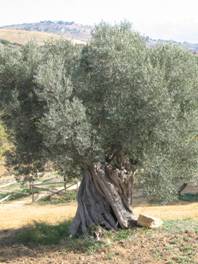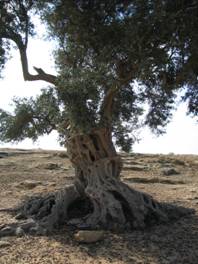|


ullaegino©UllaSiracusa
|
To know an olive tree well, it is
necessary to go to the southern coast of Sicily, where the strong warm “scirocco” wind,
which blows across the sea from Africa, reaches
this part of the island first. This warm wind is like a gentle caress which
rustles those two-color leaves particular to the olive tree.
Here, as Homer describes, the color of the eyes of Athena are at last revealed.
I have always considered the olive tree as a gift from Athena rather than a
plant introduced by Mycenaean’s or Phoenicians. If the plant was a gift from
a goddess, the olive was a tribute from Aristeo, the son of Apollo, who
possessed the know-how. It seems that it was he who passed on this knowledge
to our ancestors.
A sacred plant?
It has always been so.
Sacred also for Christians. Olive oil is used for Christenings, Confirmation,
Extreme Unction, the ordination of priests, the consecration of altars; Our
farmers know it well. Perhaps this is why those fruits are still referred to
using terms of endearment in the feminine forms “bianculidda”, “nuciddara”,
“carbucia”, “ogghiarola”.
A plant for poets?
“There is an Arab olive tree, big in the middle of the scene with which I
resolved everything”.
These were the words of the celebrated author Pirandello who felt, death was
near, while compiling “I Giganti della Montagna”. It was not a detail, a
simple solution to the scene, instead, according to Leonardo Sciascia,
another great Sicilian writer, it was a “...solution to catharsis” which
defined and concluded the whole work, his whole life. An Arab olive tree as a
symbol of a place, a symbol of his Memory”. Looking in dictionaries and
agricultural texts for a definition of the “Arab olive tree”, it is not
mentioned, even though it would seem to be perfectly eligible for a place at
last in a dictionary. Pirandello, Quasimodo and many other writers from Sicily
have mentioned it, compiling accurate descriptions with precise details.
Surely you also would have seen the Arab olive tree. It is the one with the twisted
trunk which is almost screwed down on itself, rich in cracks and seems to
have suffered torture in the past looking at all its scars. Yet in the books
it does not exist. It must be a tree which belongs to a unique botanical
species, reserved for poets alone, and to those who saw the moon reside there
where there is the renewal of life, peace and fertility. A Greek professor used
to say, that the sacred olive tree of the Acropolis governed the path of life
and destiny of the Greeks and therefore also ours. Planting an olive tree is
an act of faith - of hope and trust in the future considering its slow growth
and exceptional long life. “The little olive trees are planted for our
children” according to the Tuscans.
It is always a pleasure eating a slice of
warm bread drizzled with olive oil; It means eating the old way. The sign of
an ancient well-being as dreamed by our ancestors.
|

